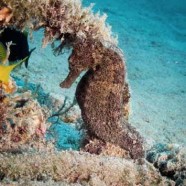“On the Trail” n°2
Take a trip of beauty and cruelty in the following 80 pages (pdf. 4Mo), swing through the trees with the supreme pleated gibbon, still at liberty in the wild despite being endangered, get to the bottom of cyanide and of poisoned pineapples, survive the etorphine laced arrows, scheme with furniture dealers looking for ivory, discover the cunning tiger trappers, hunt down blackbucks with Bollywood stars, cruise towards China with 2,000 saiga antelope horns worth 22 million dollars, look into the eyes of a baby chimpanzee in a pathetic plastic bag at a Cameroon market, entrench yourselves in the fate of thousands of birds and animals unwilling migrants forcefully removed from their habitats, float down a river with a mutilated elephant carcass and find out about France’s stance on the future of illegal ivory stockpiles, eat Ganges river dolphin meat, pay homage to rangers and forest guards murdered in the wild by poachers …
Seahorses, queen conches and sharks, pages 4 and 5
CITES has no cure for elephant poaching
Compromise and Rhetoric is killing world’s elephants
Despite the praise for the Convention on International Trade in Endangered Species of Wild Fauna and Flora on its 40th anniversary, CITES has failed to protect the elephant. African elephant populations are under siege and in decline primarily to satiate the demand for ivory in Asia. In 2011 alone, around 25,000 elephants or more were slaughtered for their ivory and the killing was even worse in 2012.
Enough is enough. Several conservation and animal welfare organizations, including the David Shepherd Wildlife Foundation (DSWF-United Kingdom), Elephant Advocacy League (United States), Environmental Investigation Agency (EIA-United Kingdom), Fondation Franz Weber (FFW-Switzerland), International Ranger Federation (Australia), Last Great Ape Organization (LAGA-Cameroon), Pro Wildlife (Germany), Robin des Bois (France), Youth for Conservation (Kenya) attending the 16th meeting of the CITES Conference of the Parties are outraged by the failure of CITES to stop the poaching of African elephants, particularly African elephants. Instead of demanding an end to the markets driving the slaughter, CITES Parties are coming up with weak compromises in a feeble attempt to stop the poaching. But China, the single country most responsible for the crisis due to its burgeoning ivory market, won’t even concede its responsibility as the main problem. Nor will CITES admit that previous decisions allowing “legal” sale of ivory to China and Japan have stimulated, not reduced, demand and directly contributed to the poaching.
The Capitalism of Extinction
Convention on International Trade in Endangered Species of Wild Fauna and Flora
CITES 2013 – Bangkok, 6 pm (local time)
Press Release No. 7
Making money from the extinction of species could become an industry of the future. It has certainly been developed by CITES – Convention on International Trade in Endangered Species of Wild Fauna and Flora.
Looking at the re-opening of international ivory trade, CITES has published à call of tender for an “independent study”. It has been attributed to specialized consultants from southern Africa. Among the 5 authors, Rowan Martin, director of research on wild fauna in Zimbawe, and Debbie A. Peake, one of the best taxidermists of Botswana, are also present. The main recommendation of the study co-financed by the European Union is to create CISO (Central Ivory Selling Organization), a single office for ivory sales. CISO would be modeled after the Diamond Trading Company (DTC), this De Beers Company has lasted over 100 years. One director, named by the main producing states, regulates trade to recognized and accredited governments or private processing companies. Short routes reduce the risks of mixing in illegal ivory. Inter-African sales would be prohibited. The report proposes that it would be possible to collect 8 tons of ivory each year for every 10,000 elephants killed by slaughter, hunting, or natural causes. The authors highlight that this management of ivory would be possible only in the absence of civil disorder and arms conflicts in producing countries. Within the report, ivory is an ore distanced from all biological, ethical and cultural considerations.
CITES: Over 40 years old and long in the tooth
Convention on International Trade in Endangered Species of Wild Fauna and Flora
CITES 2013 – Bangkok
At its signature 40 years ago, the Convention on International Trade in Endangered Species of Wild Fauna and Flora, was visionary; a fact highlighted by speeches at Bangkok during the opening of its 16 plenary session. Today, it’s falling behind. CITES is disconnected from chemical and radioactive contamination of wildlife, climate change, political chaos and population changes that increase the speed of the extinction of biodiversity.











